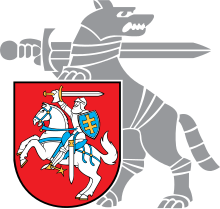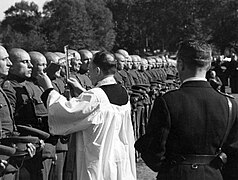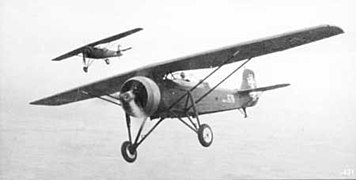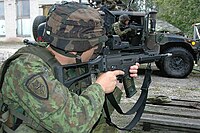Lithuanian Army
|
|||

|
|||
| guide | |||
|---|---|---|---|
| Commander in Chief : |
Defense Minister (in case of war: President Gitanas Nausėda ) |
||
| Defense Minister: | Raimundas Karoblis | ||
| Military Commander: |
Lieutenant General Valdemaras Rupšys |
||
| Headquarters: | Vilnius | ||
| Military strength | |||
| Active soldiers: | 12,000 (2015) | ||
| Conscription: | 9 months | ||
| Resilient population: | 677,689 men (2009) 743,468 women (2009) |
||
| Eligibility for military service: | 19-45 | ||
| household | |||
| Military budget: | € 894 million (2018) | ||
| Share of gross domestic product : | 2% (2018) | ||
| history | |||
| Founding: | November 23, 1918 ( Order No. 1 to build an army) | ||
| Factual foundation: | March 11, 1990 (regaining independence) | ||
The Lithuanian Army ( Lithuanian Lietuvos kariuomenė ) is the military of the Republic of Lithuania . The history of the armed forces is closely linked to the history of the country, which only regained its independence in the 1990s.
Lithuania is a member of NATO . Due to the country's limited financial possibilities, certain defense tasks are carried out together with neighboring Baltic states and / or other partner states.
history
prehistory
In the 14th century, the Grand Duchy of Lithuania was the only state in Eastern Europe that could effectively fight the Golden Horde militarily. Due to the constant military pressure from the outside that led Union of Krewo an alliance between Poland and Lithuania, which in 1569 in the Lublin Union to Real Union was transformed, which existed until the 1795th
Between the world wars
Still occupied by the German Empire , Lithuania declared its independence from the Russian Empire in 1918 and started to build its own armed forces. After fighting against the Red Army and Polish troops, the country's independence was also achieved in the period that followed. In 1935 the Lithuanian army had around 1,800 officers and around 28,000 non-commissioned officers and soldiers.
Student at the Kaunas War School (1938)
The country soon came under pressure from its neighbors again. In the run-up to the Second World War , Lithuania had to return Memelland , which it had occupied in 1923, to the German Reich in March 1939 . In the same year, after regaining the Vilnius region, the number of soldiers rose to 33,000. In addition, in view of the tense international situation, after the German attack on Poland , a partial mobilization took place. The army grew to 87,000 soldiers in September 1939 and up to a quarter of the state budget was spent on defense. Eventually up to 500,000 men served in the military. The military was fairly well equipped and had considerable authority in the state.
After the defeat of the protective power France in the western campaign , Lithuania still had little to oppose to its overpowering neighbors. For example, after the invasion of Soviet troops in the summer of 1940, a pro-Soviet government was brought into office and declared it would join the Soviet Union . In June / July 1941 German armed forces conquered the Lithuanian territory. In the summer of 1944, the Red Army reoccupied large parts of Lithuania and re-established the Lithuanian Soviet Socialist Republic (LSSR). The military resistance of the “ Forest Brothers ” against the Soviet occupation was lost without foreign support, had shrunk to a few partisan units from 1948 and was finally discontinued.
The time since 1991
Lithuania regained its national independence in 1991 and introduced compulsory military service a year later . The Russian army withdrew from Lithuania in 1993. In the period that followed, the Lithuanian armed forces oriented themselves towards the west (joining NATO in 2004) and took part in various international missions and maneuvers. In addition, the troops' equipment was gradually modernized, depending on the country's financial resources.
At the end of February 2015 it became known that Lithuania intends to reintroduce compulsory military service due to the Ukraine crisis (initially temporarily for a period of five years) after it had been abolished in 2008. A corresponding draft law was introduced to parliament in March 2015 and approved by 112 votes to three with five abstentions. The service period is nine months, around 3,500 citizens are to be drafted annually. In addition, the military budget, which at times was below one percent of GDP, is being increased again.
organization
structure
The Lithuanian Army consists of the High Command and Defense Staff:
-
 High Command ( Lithuanian Vadovybė )
High Command ( Lithuanian Vadovybė ) -
 Defense staff ( Gynybos štabas )
Defense staff ( Gynybos štabas )
the four branches of the armed forces:
-
 Land Forces ( Sausumos pajėgos )
Land Forces ( Sausumos pajėgos )
-
 Naval Forces ( Karinės jūrų pajėgos )
Naval Forces ( Karinės jūrų pajėgos ) -
 Air Force ( Karinės oro pajėgos )
Air Force ( Karinės oro pajėgos ) -
 Special Operation Forces ( Specialiųjų operacijų pajėgos )
Special Operation Forces ( Specialiųjų operacijų pajėgos )
as well as support areas such as B .:
-
 Logistics command ( Logistikos valdyba )
Logistics command ( Logistikos valdyba ) -
 Training and education command ( Mokymo ir doktrinų valdyba )
Training and education command ( Mokymo ir doktrinų valdyba ) -
 Military Police ( Karo policija )
Military Police ( Karo policija )
The border troops ( Valstybės sienos apsaugos tarnyba prie Lietuvos Respublikos vidaus reikalų ministerijos ) are not part of the army. Like the Federal Border Police in the Federal Republic of Germany , they are subordinate to the Interior Ministry.
Team numbers
- Land forces: 10,120 (of which 4,720 in the volunteer organizations)
- Naval Forces: 550
- Air Force: 1035
- Logistics command: 1200
- Training and education command: 670
High command
The armed forces report directly to the Lithuanian Ministry of Defense . According to the constitution , the president is the supreme commander in a state of defense .
The current military commander of the armed forces is Lieutenant General Valdemaras Rupšys . The commander of the land forces is Brigadier General Raimundas Vaikšnoras , the navy commander, Captain Giedrius Premeneckas, and the air force commander, Colonel Dainius Guzas.
Military commanders of the armed forces have been:
| Surname | Start of service | Service end |
|---|---|---|
| (1918–1940) | ||
| Silvestras Žukauskas | NN | NN |
| Stasys Raštikis | 1935 | 1940 |
| Kariuomenės vado (since 1993) | ||
| Jonas Andriškevičius | October 20, 1993 | July 1, 1999 |
| Jonas Kronkaitis | July 1, 1999 | June 30, 2004 |
| Valdas tutkus | June 30, 2004 | July 3, 2009 |
| Arvydas Pocius | July 24, 2009 | July 24, 2014 |
| Jonas Vytautas Žukas | July 24, 2014 | July 24, 2019 |
| Valdemaras Rupšys | since July 24, 2019 | |
Initial and continuing education
The training and further education of the Lithuanian soldiers is coordinated centrally by the training command ( Lithuanian Mokymo ir doktrinų valdyba ). The Hetman Jonušas Radvila Training Regiment , the General Adolfas Ramanauskas Combat Training Center and the Divisional General Stasys Raštikis Military School are available for the actual training . The officers' training takes place at the General Jonas Žemaitis Military Academy .
In addition, there are numerous educational institutions that are operated jointly with the Estonian and Latvian armed forces . The Baltic Defense Academy (BALTDEFCOL) in Tartu , where the future staff officers of the Baltic republics are trained, is just one example .
equipment
Land Forces
The most important part of the armed forces is the Lithuanian army . This has:
- vehicles
- 175 M113 armored transport vehicles , delivered by Germany between 2000 and 2010
- 10 armored personnel carriers BRDM-2 , from old Soviet stocks
- 8–10 MT-LB amphibious transport vehicles , supplied from Poland
- 40 humvees
-
Howitzers
- 72 M101 howitzers , supplied by Germany and Denmark until 2005
- 2 self-propelled howitzers 2000 , further units and accessories will be delivered from Germany until 2019
- Anti-tank weapons
Since 2003, the armed forces have been using the HK G36 made in Germany as their standard rifle.
Naval forces

The Lithuanian naval forces operate the Baltic Sea Squadron BALTRON in cooperation with the neighboring Baltic states . The most important naval base is Klaipėda . There is u. a. the fleet is stationed, which has the following units:
- Anti-mine vehicles (former British Hunt-class boats and German Lindau-class mine hunters )
- Patrol boats (four formerly Danish Flyvefisken-class boats)
- various auxiliary and support ships
The Navy also has a diving department. In addition, she is responsible for maritime and coastal surveillance as well as sea rescue.
Air Force

The Lithuanian Air Force uses Šiauliai Airport . It operates the BaltNet air surveillance system with its Baltic neighbors . The Air Force has:
Airplanes:
- 1–2 jet trainers Aero L-39
- 3 Alenia C-27 J "Spartan" transport aircraft
- 5 Yakovlev Yak-52 trainer aircraft
- 2 Let L-410 transport aircraft
Helicopter:
Air defense systems:
International cooperation
Since regaining independence, the Lithuanian armed forces have participated in various international missions abroad. As a member of the coalition of the willing , Lithuania has sent troops to Iraq and Afghanistan . On June 14, 2009, during a meeting of EU defense ministers, an agreement was reached to establish a Lithuanian-Polish-Ukrainian brigade .
In addition, one tries to increase the defense capability of one's own country through international cooperation. Already in the years of the reorganization one began to cooperate on various projects with the Baltic neighboring states (BALTRON, BaltNet etc.). However, joining NATO can be seen as the greatest milestone. The country has participated in NATO's Partnership for Peace program since 1994 and has been a regular member of the alliance system since 2004. The NATO Battlegroup Lithuania was set up as part of the Ukraine crisis and the strengthening of NATO's eastern flank . It is an international NATO association under German leadership. In the course of rearmament in the Baltic States, the USA also stationed M1 Abrams , M2 / M3 Bradley and Humvees battle tanks in Lithuania, Estonia and Latvia .
Military personnel
Generals 1569–1795
- Simon Kossakowski (1741–1794)
- Joseph Korwin-Kossakowski ( Polish Józef Korwin-Kossakowski ), (1772–1842), adjutant to Napoleon
Generals 1918–1940
- Edvardas Adamkevičius (1888–1957), division general
- Feliksas Baltušis-Žemaitis (1897–1957), Brigadier General
- Juozas Barzda-Bradauskas (1896–1953), Brigadier General
- Albinas Čepas-Čepazier (1896–1961), Brigadier General
- Jonas Černius (1898–1977), Brigadier General and Prime Minister
- Teodoras Daukantas (1884–1960), major general
- Jonas Galvidis-Bikazier (1864–1943), major general
- Zenonas Gerulaitis (1894–1945), Major General
- Viktoras Giedrys (1894–1955), Brigadier General
- Antanas Gustaitis (1898–1941), Brigadier General
- Jonas Jackus (1894–1977), Lieutenant General
- Jonas Joudisius (1893–1950), Brigadier General
- Vladis Karvelis (1902–1980), Brigadier General
- Maksimas Katche (Max Kattchée), (1879–1933), Lieutenant General
- Juozas Kraucevičius (1879–1964), Lieutenant General
- Petras Kubiliūnas (1894–1946), Lieutenant General
- Jurgis Kubilius (1875–?), Lieutenant General
- Kazys Ladyga (1893–1941), Lieutenant General
- Pranas Liatukas (1876–1945), Lieutenant General
- Vladas Mezialis (1894–1966), Brigadier General
- Kazys Musteikis (1894–1977), Brigadier General
- Vladas Nagius-Nagevicius (1881–1954), Brigadier General
- Stasys Nastopka (1891–1938), Lieutenant General
- Kazimieras Navakas (1894–1945), Brigadier General
- Klemensas Popeliučka (1892–1948), Brigadier General
- Motiejus Pečiulionis (1888–1960), Lieutenant General
- Povilas Plechavičius (1890–1973), Lieutenant General
- Stasys Pundziavičius (1893–1980), major general
- Leonas Radus-Zenkavicius (1874–1946), Lieutenant General
- Stasys Raštikis (1896–1985), division general
- Mikas Reklatis (1895–1976), Major General
- Kazys Skučas (1894–1941), Brigadier General
- Jonas Sutkus (1893–1942), Lieutenant General
- Kazys Tallat-Kelpsa (1893–1968), Brigadier General
- Pranas Tamašauskas (1880–1951), Brigadier General
- Adolfas Urbšas (1900–1973), major general
- Mykolas Velykis (1884–1955), Major General
- Emil Vimieris (1885–1974), Brigadier General
- Vincas Vitkauskas (1890–1965), Lieutenant General
- Vincas Žilys (1896–1972), Brigadier General
- Silvestras Žukauskas (1860–1937)
Generals and Admirals since 1991
- Jonas Andriškevičius (* 1944), major general, most recently commander of the Lithuanian armed forces (1993–1999)
- Remigijus Baltrėnas , Brigadier General
- Raimundas Saulius Baltuška (1937–2016), flotilla admiral, most recently commander of the Lithuanian naval forces (1992–1999)
- Česlovas Jezerskas (* 1949), Brigadier General, former Inspector General of the Armed Forces
- Jonas Kronkaitis (* 1935), major general, most recently in command of the Lithuanian armed forces (1999-2004)
- Zenonas Kulys (* 1947) Brigadier General, former commander of the General Jonas Žemaitis Military Academy of Lithuania (1993–2000)
- Almantas Leika (* 1968), Brigadier General, Deputy Chief of Staff at NATO Joint Force Command Brunssum (since 2016)
- Kęstutis Macijauskas (* 1961), flotilla admiral, most recently representative of Lithuania at the Supreme Headquarters Allied Powers Europe (2015-2019)
- Edvardas Mažeikis (* 1961), Major General, most recently Director of the NATO Standardization Office (2014-2018)
- Arūnas Mockus (* 1969), Flotilla Admiral, Commander of the Lithuanian Naval Forces (2015-2020)
- Modestas Petrauskas , Brigadier General, Representative of the Lithuanian Armed Forces to NATO and the EU (since 2018)
- Arvydas Pocius (* 1957), Lieutenant General, most recently Commander of the Lithuanian Armed Forces (2009-2014)
- Valdemaras Rupšys (* 1967), Lieutenant General, Commander of the Lithuanian Armed Forces (since 2019)
- Mindaugas Steponavičius (* 1974), Brigadier General, Commander of the Training and Education Command (since 2019)
- Vilmantas Tamošaitis (* 1966), Brigadier General, Inspector General of the Armed Forces (since 2019)
- Valdas Tutkus (* 1960), Lieutenant General, most recently Commander of the Lithuanian Armed Forces (2004–2009)
- Algis Vaičeliūnas (* 1964), Brigadier General, most recently in command of the General Jonas Žemaitis Military Academy (2017-2018)
- Raimundas Vaikšnoras (* 1970), Brigadier General, Commander of the Lithuanian Land Forces (since 2019)
- Vitalijus Vaikšnoras (* 1961), major general, most recently Lithuanian chief of staff (2016-2019)
- Gintautas Zenkevičius (* 1962), major general, Lithuanian chief of staff (since 2019)
- Jonas Vytautas Žukas (* 1962), Lieutenant General, most recently Commander of the Lithuanian Armed Forces (2014-2019)
Web links
- Lithuanian Ministry of Defense (English)
- Lithuanian Armed Forces (English, Lithuanian)
Individual evidence
- ↑ Financial and Economic Data Relating to NATO Defense (PDF, 424kB) , NATO press release of June 22, 2015, accessed on March 8, 2016.
- ↑ a b Lietuvas valdība piešķir aizsardzības izdevumiem vēl 21.5 miljonus eiro, lai tie sasniegtu 2% no IKP , online report on www.sargs.lv of November 29, 2018, accessed on December 1, 2018 (Latvian).
- ↑ Armed Forces Day (English).
- ^ Mathias Niendorf: The Grand Duchy of Lithuania. Studies on nation building in the early modern period (1569–1795) - Publications of the Nordost-Institut 3. Harrassowitz Verlag, Wiesbaden 2006, ISBN 3-447-05369-0 (also: Kiel, Univ., Habil.-Schr., 2003) .
- ↑ Ką savo didžiausiu ir pavojingiausiu priešu laikė Lietuvą okupavę sovietai? (Daily newspaper Panevėžio balsas and portal Alfa.lt )
- ↑ Lithuania has an online report on faz.net, accessed on March 20, 2015.
- ↑ White Paper on Lithuanian defense policy (download source at http://kam.lt) , accessed on September 18, 2017 (English).
- ^ Lithuania Land Forces Equipment on globalsecurity.org, accessed July 10, 2016.
- ↑ Online notification of the Lithuanian Ministry of Defense of June 24, 2016, accessed on August 11, 2016 (English).
- ^ Lithuanian Air Force Equipment on globalsecurity.org, accessed July 10, 2016.
- ^ Robert Rochowicz: List intencyjny w sprawie LITPOLUKRBRIG podpisany ( memento of November 26, 2009 in the Internet Archive ), Polska Zbrojna, November 16, 2009 (Polish).
- ↑ Online report from March 9, 2015 , accessed on March 10, 2015.
- ↑ Online report at tagesschau.de from March 10, 2015 ( Memento from March 11, 2015 in the Internet Archive ), accessed on March 12, 2015.





